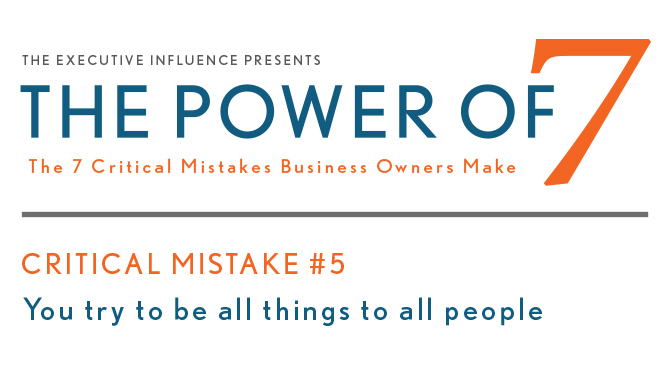A common fear for business owners is that if they define their target too narrowly, then they will lose business. This is a common and (potentially) fatal assumption. As a result many business owners will continue to invest in new product or service development with the hope of becoming a “one stop shop” for their clients. Effectively promoting all of the products and services to the (perceived) expanded audience becomes expensive, shortcuts are taken and the overall marketing message is severely diluted.
The first step in avoiding the “all things to all people” approach is to reexamine what your strengths are and what you set out to do when the firm was founded. Good questions to start the process are:
Revisit your target market description. Have we been consistently hitting it? If not, why?
What do we sell the most of? Are add-ons or options frequently requested by our clients? If so, which?
What are our vision and mission statements? Are we remaining true to our guiding principles?
What is our market potential for the existing products or services? Describe your largest and most common competitors. Compare your share to market size. What can you do to improve your performance?
Once the market position of the company is reestablished, then a stronger, updated marketing plan can be developed and put into play.
A byproduct of an updated, focused marketing plan is your company becoming recognized as the experts in your field. Your company’s credibility rises accordingly as you receive recognition and referrals are much easier for your clients and business partners (they can tell others exactly what you offer). Becoming an expert in your field not only makes you to stand out from the crowd, but allows you to earn a higher margin as your clients easily recognize the value of doing business with your company.
A terrific example of target market effectiveness is with Southwest Airlines and the way they approached flight routing. Traditional airline strategy was to operate central hubs to route passengers through (hub and spoke distribution) to maximize physical locations and flight capacity. Southwest approached logistics with a “point to point” system that allowed passengers to fly without passing through a central hub. Combined with aggressive pricing and over-the-top customer service, Southwest Airlines has developed an industry leadership position and a loyal flyer base.
Targeting a specific market segment can leave a business owner feeling very uncomfortable and limited. Clearly defining a target market will result in more efficient promotional efforts while positioning the company as a leader in its field.
Marketing programs are among the most common, challenging and misunderstood operations by business owners. The Executive Influence has years of successfully supporting business owners and operators through effective marketing planning that drives company growth. Contact us today and expect results.

